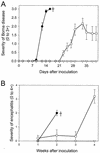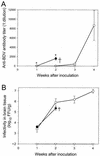Enhanced neurovirulence of borna disease virus variants associated with nucleotide changes in the glycoprotein and L polymerase genes
- PMID: 12163584
- PMCID: PMC136970
- DOI: 10.1128/jvi.76.17.8650-8658.2002
Enhanced neurovirulence of borna disease virus variants associated with nucleotide changes in the glycoprotein and L polymerase genes
Abstract
Borna disease virus (BDV) infection produces a variety of clinical diseases, from behavioral illnesses to classical fatal encephalitis (i.e., Borna disease [BD]). Since the genomes of most BDV isolates differ by less than 5%, host factors are believed responsible for much of the reported variability in disease expression. The contribution of BDV genomic differences to variation in BD expression is largely unexplored. Here we compared the clinical outcomes of rats infected with one of two related BDV variants, CRP3 or CRNP5. Compared to rats inoculated with CRP3, adult and newborn Lewis rats inoculated with CRNP5 had more severe and rapidly fatal neurological disease, with increased damage to the hippocampal pyramidal neurons and rapid infection of brain stem neurons. To identify possible virus-specific contributions to the observed variability in disease outcome, the genomes of CRP3 and CRNP5 were sequenced. Compared to CRP3, there were four nucleotide changes in the CRNP5 variant, two each in the G protein and in the L polymerase, resulting in four amino acid changes. These results suggest that small numbers of genomic differences between BDV variants in the G protein and/or L polymerase can contribute to the variability in BD outcomes.
Figures






Similar articles
-
Restricted expression of Borna disease virus glycoprotein in brains of experimentally infected Lewis rats.Neuropathol Appl Neurobiol. 2008 Dec;34(6):590-602. doi: 10.1111/j.1365-2990.2008.00940.x. Epub 2008 Feb 14. Neuropathol Appl Neurobiol. 2008. PMID: 18282160
-
Gene expression of the TGF-beta family in rat brain infected with Borna disease virus.Microbes Infect. 2009 Jul-Aug;11(8-9):737-43. doi: 10.1016/j.micinf.2009.04.014. Epub 2009 Apr 17. Microbes Infect. 2009. PMID: 19376261
-
Bornavirus and the brain.J Infect Dis. 2002 Dec 1;186 Suppl 2:S241-7. doi: 10.1086/344936. J Infect Dis. 2002. PMID: 12424704 Review.
-
Kinetics of virus spread and changes in levels of several cytokine mRNAs in the brain after intranasal infection of rats with Borna disease virus.J Virol. 1992 Feb;66(2):992-8. doi: 10.1128/JVI.66.2.992-998.1992. J Virol. 1992. PMID: 1731117 Free PMC article.
-
Molecular and cellular biology of Borna disease virus infection.Microbes Infect. 2002 Apr;4(4):491-500. doi: 10.1016/s1286-4579(02)01564-2. Microbes Infect. 2002. PMID: 11932200 Review.
Cited by
-
Live Viral Vaccine Neurovirulence Screening: Current and Future Models.Vaccines (Basel). 2021 Jun 30;9(7):710. doi: 10.3390/vaccines9070710. Vaccines (Basel). 2021. PMID: 34209433 Free PMC article. Review.
-
Pathogenic potential of borna disease virus lacking the immunodominant CD8 T-cell epitope.J Virol. 2007 Oct;81(20):11187-94. doi: 10.1128/JVI.00742-07. Epub 2007 Aug 8. J Virol. 2007. PMID: 17686872 Free PMC article.
-
Interferon-gamma prevents death of bystander neurons during CD8 T cell responses in the brain.Am J Pathol. 2009 May;174(5):1799-807. doi: 10.2353/ajpath.2009.080897. Epub 2009 Apr 9. Am J Pathol. 2009. PMID: 19359516 Free PMC article.
-
Bornavirus : Stellungnahmen des Arbeitskreises Blut des Bundesministeriums für Gesundheit.Bundesgesundheitsblatt Gesundheitsforschung Gesundheitsschutz. 2019 Apr;62(4):519-532. doi: 10.1007/s00103-019-02904-2. Bundesgesundheitsblatt Gesundheitsforschung Gesundheitsschutz. 2019. PMID: 30820613 German. No abstract available.
-
Borna disease virus.J Neurovirol. 2003 Apr;9(2):259-73. doi: 10.1080/13550280390194064. J Neurovirol. 2003. PMID: 12707857 Review.
References
-
- Almond, J. W. 1977. A single gene determines the host range of influenza virus. Nature 270:617-618. - PubMed
-
- Anzil, A. P., K. Blinzinger, and A. Mayr. 1972. Persistent Borna virus infection in adult hamsters. Arch. Gesamte Virusforsch. 40:52-57. - PubMed
-
- Bautista, J. R., G. J. Schwartz, J. C. de la Torre, T. H. Moran, and K. M. Carbone. 1994. Early and persistent abnormalities in rats with neonatally acquired Borna disease virus infection. Brain Res. Bull. 34:31-40. - PubMed
-
- Binz, T., J. Lebelt, H. Niemann, and K. Hagenau. 1994. Sequence analyses of the p24 gene of Borna disease virus in naturally infected horse, donkey and sheep. Virus Res. 34:281-289. - PubMed
Publication types
MeSH terms
Substances
Associated data
- Actions
- Actions
- Actions
Grants and funding
LinkOut - more resources
Full Text Sources
Other Literature Sources

